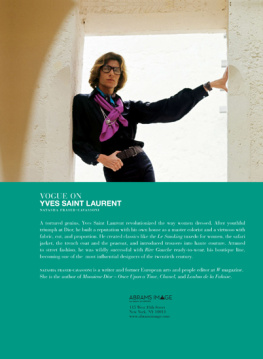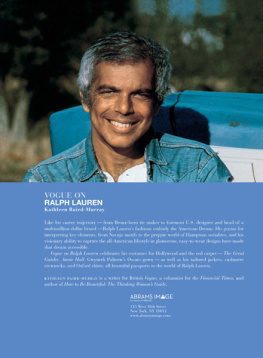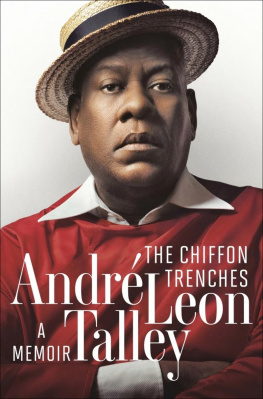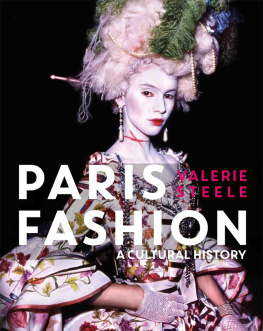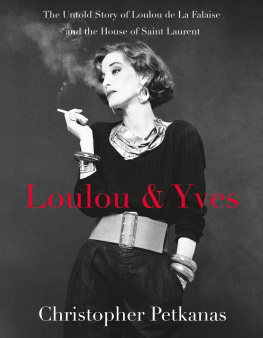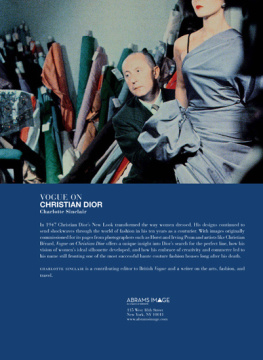
Model Carrie Nygren in Rive Gauches black double-breasted jacket and mid-calf skirt with long-sleeved white blouse; styled by Grace Coddington, photographed by Guy Bourdin, 1975.

Linda Evangelista wears an ostrich-feathered couture slip dress inspired by Saint Laurents favourite dancer, Zizi Jeanmaire. Photograph by Patrick Demarchelier, 1987.


At home in Marrakech, Yves Saint Laurent models his new ready-to-wear line, Rive Gauche Pour Homme. Photograph by Patrick Lichfield, 1969.
CHRISTIAN DIOR TAUGHT ME
THE ESSENTIAL NOBILITY OF A
COUTURIERS CRAFT.
YVES SAINT LAURENT
DIORS DAUPHIN
A
I n fashion history, Yves Saint Laurent remains the most influential designer of the latter half of the twentieth century. Not only did he modernize womens closetsmost importantly introducing pants as essentialsbut his extraordinary eye and technique allowed every shape and size to wear his clothes. My job is to work for women, he said. Not only mannequins, beautiful women, or rich women. But all women. True, he dressed the swans, as Truman Capote called the rarefied group of glamorous socialites such as Marella Agnelli and Nan Kempner, and the stars, such as Lauren Bacall and Catherine Deneuve, but he also gave tremendous happiness to his unknown clients across the world. Whatever the occasion, there was always a sense of being able to count on Yves. It was small wonder that British Vogue often called him The Saint because in his 40-year career women felt protected and almost blessed wearing his designs.
Although the Paris-based couturier wished that he had invented denim jeansdescribing them as the most spectacular, the most practical, the most relaxed, and nonchalant, to Vogues Gerry Dryanskyhe was behind such well-cut staples as the pea coat, the safari jacket, the trench coat, the pant suit, Le Smoking (the female tuxedo), and the introduction of black tights as the chic alternative to pale hosiery. Following in the footsteps of Coco Chanel, Saint Laurent was inspired by black, yet he was a superb colorist who with his bold choice of fabric knew how to brighten an outfit and flatter the complexion.
A s a demonstration of Vogues attention to promising fashion talent, Saint Laurent had strong links with the magazine from the very start of his career and throughout. It was via Vogues Michel de Brunhoff that he met Christian Dior, his first and only boss. It was through the enthusiasm of Vogues Diana Vreeland that the American public became instantly sold on Rive Gauche, Saint Laurents ready-to-wear line. Meanwhile, Helmut Newtons iconic Smoking portrait taken in 1975 and other memorable images by the likes of Richard Avedon, David Bailey, Guy Bourdin, and Irving Penn were first viewed within the pages of Vogue.

Helmut Newton said Saint Laurent inspired his best fashion photos. His mythic portrait of Vibeke Knudsen wearing Le Smoking on the rue Abriot appeared in Vogue Paris in 1975. The pairing of tailored pant suit and soft blouse typified Saint Laurents masculine-feminine ambiguity.

Naomi Campbell, a frequent Saint Laurent model, photographed by Patrick Demarchelier in 1987 as a haute-couture-clad showgirla favorite nighttime look of the couturiers.

Rive Gauche shirt, sunglasses, and jewelry, are exotically displayed on Marie Helvin, another Saint Laurent favorite, photographed by David Bailey in 1975.
A GOOD MODEL CAN ADVANCE FASHION BY TEN YEARS.
YVES SAINT LAURENT

Carla Bruni photographed by Dewey Nicks in 1994, wearing Saint Laurents short couture silk faille evening dress, highlighted with jewelry designed by Loulou de la Falaise.

Lucienne Saint Laurent, photographed for British Vogue by Willy Rizzo in 1960 with the irrepressibly pleased expression of someone whose son has just pulled off an immensely successful coup. To set off her dramatic coloring, she was wearing a turquoise cardigan suit, from Saint Laurents couture collection for Christian Dior.
Saint Laurent epitomised the expression highly strung. Pierre Berg, his business partner and one-time lover, described him as being born with a nervous breakdown. Still, whatever his moodI am a persistent depressive, he told British Vogues Lesley Whiteor mental state, Saint Laurent never lost his adoring fashion audience. The interest in his personal welfare never faded. Though viewed as the king of couture and one of the great talents, Saint Laurent was seen as human, and he touched people by his vulnerabilityno doubt because he seemed authentic, and had always dared to be different and romantic. His declaration that for a woman to look beautiful all she needs is to be in the arms of the man she loves demonstrated this. A poetic thought, it suggested that he cared about women beyond clothes: Yves le Sducteurthe designer who both seduced with his perfect proportions and with his person.
F rom an early age, adoring females surrounded the designer. Born on August 1st, 1936 in Oran, Algeria, Yves Henri Donat Mathieu-Saint-Laurent was the apple of his mother Luciennes eye. Cherubic, with large blue eyes and wide, smiling mouth, he displayed none of the anguish that would later cloud his features. He was a happy and cherished petit prince. Two younger sistersMichle and Brigittewere to follow. I love my daughters, of course, Lucienne told Vogues Dryansky, but for Yves, theres always been something very strong and very special.
Women are intrinsically mysterious, veiled, enigmatic.
YVES SAINT LAURENT

Illustrating Saint Laurents sensual way with fur, Nancy Donahue sports Rive Gauches suede coat, lined in squirrel with silver fox collar. Photograph by Eric Boman, 1980
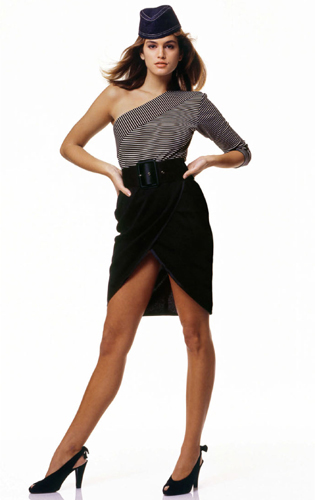
Cindy Crawford wears Rive Gauches one-sleeve silk top with tulip sarong, an example of Saint Laurents fondness for an asymmetrical style. Photograph by Patrick Demarchelier, 1987
Next page
